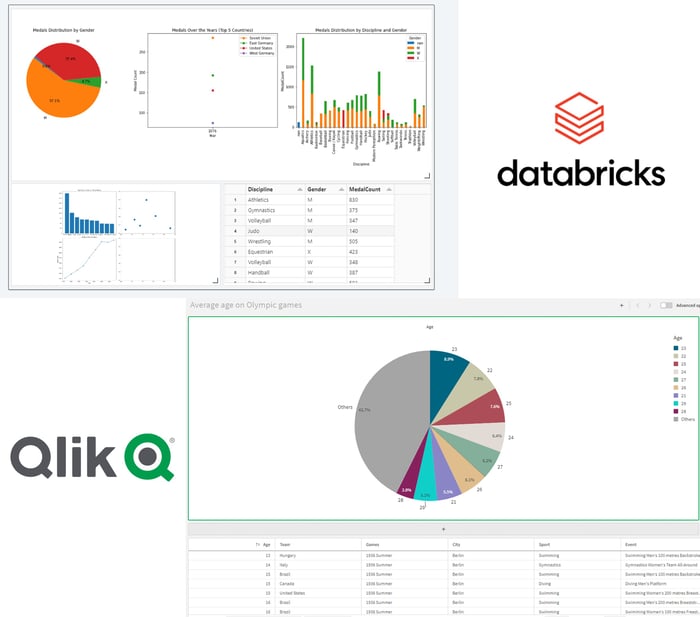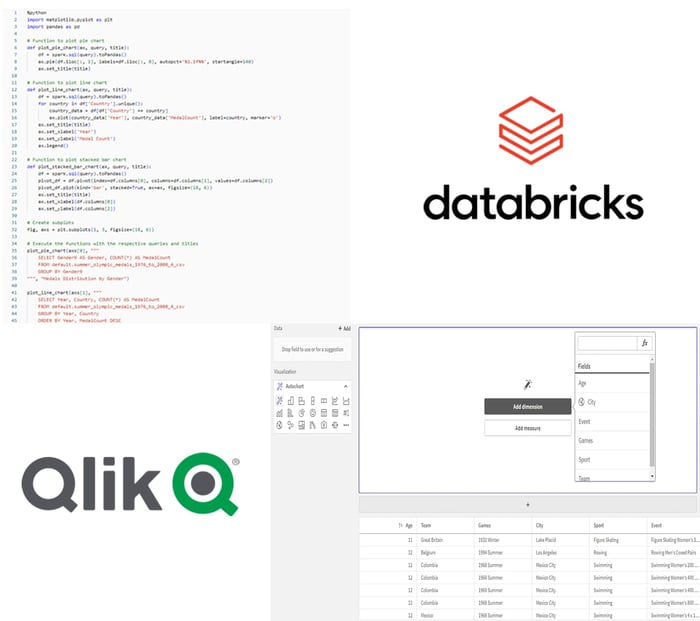Data is the lifeblood of any company, serving as the crucial foundation upon which informed decisions, strategic planning, and overall organizational success to thrive. Qlik and Databricks SQL are two programs that are aiming to help companies create meaningful insights from your data and organize them. In this article, we will provide a brief introduction to each program, exploring their unique features. Subsequently, we will compare the similarities and differences between Databricks SQL, which focuses on organizations dealing with big data analytics and machine learning, and Qlik, a powerful data visualization and business intelligence tool primarily designed for fitting the needs of bigger businesses.
A short introduction to Databricks SQL
Databricks SQL is a cloud-native data analysis and SQL querying platform that simplifies and enhances the process of exploring, analyzing, and visualizing data. This platform is constructed on top of the powerful Apache Spark Computing framework, providing data professionals, analysts, and data scientists with a consolidated interface for efficiently querying structured and semi-structured data. Databricks SQL offers a collaborative and user-friendly workspace for executing SQL queries, conducting data analyzation, and creating interactive dashboards. Thanks to its scalable architecture, Databricks SQL can effortlessly handle vast datasets and execute intricate data transformations, making it an invaluable asset for organizations looking to extract meaningful insights from their data without the need for extensive data engineering. This tool promotes data accessibility and teamwork, fostering a culture of data-driven decision-making within teams and organizations.
A short introduction to Qlik
Qlik is a renowned software company specializing in data analytics and business intelligence solutions. As a data visualization tool, Qlik focuses on providing software solutions for data representation, executive dashboards, and self-service tools for business intelligence. The core of Qlik's offering is its powerful data visualization platform, which empowers users to transform raw data into meaningful insights and actionable information. Qlik's software empowers organizations with effortless access to their data, enabling seamless analysis and interpretation, ultimately streamlining the data-driven decision-making process to a considerable extent. It employs a unique associative model, which lets users explore and navigate data freely, making unexpected connections and uncovering hidden insights. With Qlik's user-friendly interface and robust data integration capabilities, businesses can gain a competitive edge by harnessing the full potential of their data for strategic planning, reporting, and business optimization. Gartner, an influential and well-respected research and advisory firm in the technology and business realm, consistently ranks Qlik as one of the foremost vendors in the data visualization and business intelligence (BI) field, standing alongside other industry giants such as Tableau and Power BI.
Similarities
Despite the fact that Qlik and Databricks SQL are two different technologies used for data analysis and management there are some similarities between them. Both of them are equipped with robust data integration capabilities, facilitating the connection to various data sources and enabling Extract, Transform, Load (ETL) operations. Furthermore, in both of the tools, users have the ability to write SQL queries for data analysis and manipulation. Interactive dashboards are also a shared feature, empowering users to create engaging visualizations and reports for data-driven decision-making. Additionally, users in both of the tools have the opportunity to make data transformations such as clean, reshape, and enrich data as needed. Moreover, these platforms provide tools for data processing and analysis while Qlik's associative data modeling helps explore data relationships, while Databricks SQL, built on Apache Spark, offers distributed data processing and machine learning. Both Qlik and Databricks SQL are adept at working with cloud services, making it easy for users to link up with popular cloud platforms. This connection allows them to take full advantage of the benefits that come with cloud-based data storage and the computing power it offers. Collaboration capabilities is another feature that users can take advantage of in both of the tools. Last but not least, both Qlik and Databricks SQL allow users to enhance their capabilities by using APIs and custom scripts. This means you can easily integrate these tools with other software, systems, or even create your unique solutions to meet specific needs.

Differences
Notwithstanding that the main purpose of Databricks SQL is different from Qlik, since the first mentioned is focused on big data analytics and machine learning and Qlik is a business intelligence and data visualization platform but the stark contrast emerges in data visualization and reporting: Databricks SQL is primarily a data processing tool, with limited visualization capabilities, while Qlik is renowned for its data visualization and reporting prowess, empowering users to create rich and interactive dashboards. Another notable difference is that Databricks SQL οften requires higher technical expertise, especially for big data and advanced analytics, whereas Qlik is celebrated for its user-friendliness, appealing to a broad range of users. Deployment options cater to organizational preferences: Databricks SQL offers a cloud-based service with flexible infrastructure choices, while Qlik can be deployed on-premises or in the cloud. The deployment options also differ since Databricks SQL offers a cloud-based service with flexible infrastructure choices, while Qlik can be deployed on-premises or in the cloud.
Another big aspect of Databricks SQL is its scalability for massive datasets and distributed computing. Furthermore, Databricks SQL excels with robust machine learning capabilities, whereas Qlik provides basic analytics features but lacks the same specialization. When it comes to community and ecosystem, Databricks SQL benefits from the vast world of big data and machine learning, while Qlik maintains its own community focused on business intelligence and data visualization. Last but not least, the pricing model also differ as described in the table below.

Do you have questions on this or any other topic?
We will be happy to support you - Simply get in touch with us.
|
Databricks SQL |
Qlik |
|
|
Cost and Licensing |
The cost of Databricks SQL depends on some factors like:
In each case the cost per program approximately is the following : SQL Classic: $0,22/DBU* SQL Pro: $0,75/DBU* SQL Serverless: 0,90/DBU* (this option it is not available in Google Cloud) Also, there is the option to pre-purchase a plan as Databricks commit unit** with a discount for a certain period of time. * Databricks Unit (DBU) A Databricks Unit (DBU) is a normalized unit of processing power on the Databricks Lakehouse Platform used for measurement and pricing purposes. The number of DBUs a workload consumes is driven by processing metrics, which may include the compute resources used and the amount of data processed. ** A Databricks commit unit (DBCU) is a unit of measurement that represents the amount of Azure Databricks usage that you pre-purchase for a certain period of time, either one year or three years. You can use the DBCU for any Azure Databricks workload or tier, such as data analytics, data engineering, or machine learning. |
Qlik Standard: 20$ per user/month Qlik Premium: 2.700$ per month Qlik Enterprise: please contact Qlik directly for a custom quote Qlik on prem: please contact Qlik directly for a custom quote
|
|
Data Sources |
Databricks SQL is compatible with various data sources.
|
Qlik can seamlessly connect to a wide array of data sources, including
|
|
Target Group |
Databricks SQL is designed for data engineers, data scientists, data analysts, and data teams. It caters to organizations dealing with big data analytics and machine learning use cases. |
Qlik primarily targets businesses and enterprises looking for powerful data visualization and business intelligence tools. |
|
Performance |
Offers high-performance query execution, thanks to its optimized query engine and distributed computing capabilities. It's suitable for processing large-scale data and complex analytics workloads. |
Qlik delivers strong performance, with the ability to rapidly process and visualize data, making it an efficient and effective choice for data analysis and exploration, though it may face challenges when dealing with very large datasets that require additional optimization. |
|
Machine learning |
Databricks SQL provides an integrated platform for machine learning capabilities, offering seamless integration with Apache Spark's MLlib. With MLflow integration and the power of Azure, it enables organizations to build, train, and manage machine learning models within their data analytics workflows. This makes Databricks SQL a valuable tool for data-driven organizations seeking to harness the potential of machine learning |
Qlik offers the ability to the users to build machine learning models and make predictions as part of their data analysis process. Qlik's associative model enables the exploration of data relationships, and its platform supports advanced analytics using external machine learning libraries and tools. Additionally, Qlik benefits from integration with Microsoft's suite of business analytics solutions, including Azure, for advanced machine learning and cloud-based data processing. |
|
Programming support |
Databricks SQL supports multiple programming languages, including:
It provides a collaborative environment for data teams to work on data engineering, analytics, and machine learning projects using these languages. |
Qlik users can work with popular programming languages like:
This diverse language support empowers data teams to collaborate and work seamlessly on data exploration, analytics, and visualization, making Qlik a flexible platform for data-driven projects across various domains. |
|
Community |
Databricks has a strong user community with active forums, knowledge sharing, and resources. The Databricks Community Edition is a free option that allows users to explore the platform and get support from the community. Paid plans offer additional support and services. |
Qlik offers the Qlik community forum which is an online platform and community for users of Qlik's business intelligence and data analytics products, including QlikView and Qlik Sense. With other words it is a place for Qlik users where they can collaborate, exchange knowledge and experience. Also, Qlik community forum is a place where users can ask and answer questions. Furthermore, Qlik provides an extensive documentation site. |
Databricks SQL vs. Qlik - Our Conclusion
In the dynamic landscape of data analytics and processing, the choice between Databricks SQL and Qlik ultimately boils down to the specific needs and objectives of your data-related projects. If you're in search of a highly scalable solution with great performance and a robust suite of machine learning capabilities, Databricks SQL stands out as the natural choice. Its proficiency in big data analytics and distributed computing makes it a significant contender for operating complex data tasks. However, if your focus is on business intelligence and creating an interactive data exploration with a user-friendly interface, then Qlik emerges as the answer. Known for its intuitive design and data visualization capabilities, Qlik caters to a wide spectrum of users.
Regardless of your chosen path, Databricks SQL and Qlik have firmly established themselves in their respective domains, offering distinct strengths to meet your company needs. Whichever direction you lean, know that we can guide you through the intricacies of your data needs, enabling you to harness the full potential of your data for well-informed decision-making. Just get in touch with us - we look forward to exchanging ideas with you.

/Logo%202023%20final%20dunkelgrau.png?width=221&height=97&name=Logo%202023%20final%20dunkelgrau.png)
























